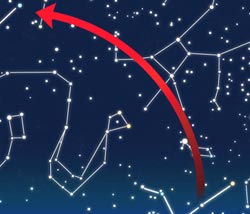Michal Levinstein, Israel Astronomical Society

Direct link to this page: https://www.hayadan.org.il/pulsar110905.html
A group of astronomers studying the radio pulsar B1508+55 achieved a surprising result - the star is moving away from our galaxy at an incredible speed of 680 miles/second (1,100 km/second). At such a tremendous speed, the galaxy's gravity is unable to hold the star in its domain. This means that he was actually "kicked" out of the galaxy. Such an "expulsion" probably belongs to a new type of neutron stars that are particularly compressed and fast.
The researchers used the National Science Foundation's Very Long Baseline Array (VLBA) to study both the star's motion and the tiny wobble in its direction caused by Earth's orbit around the Sun. This oscillation called "parallax" allowed the group to determine that the distance of the pulsar is 7,700 light years from us.
In announcing the discovery, Shami Chatterjee of the US National Radio Astronomy Observatory (NRAO) and the Harvard-Smithsonian Center for Astrophysics said the researchers: "We know that supernova explosions can result in a 'kick "Neutron stars, but the incredible speed of the star is even beyond our current understanding."
However, understanding this kind of intergalactic velocity is within our reach, claim several researchers familiar with pulsar theory.
A set of models - published by Z. Z. Arzoumanian from the Goddard Space Flight Center and D. Chernoff and G. D. Chernoff and J. Cordes from Cornell University in the USA - suggests that there are 2 fast configurations for pulsars and not one. According to their scenario, a first group of pulsars reaches a speed of 54 miles/second (90 km/second), while a second (smaller) group speeds up to 420 miles/second (700 miles/second). The neutron star B1508+55 belongs to the second group - with only 2% of all pulsars sharing this speed with it.
But why are the pulsars divided into 2 groups according to speed? To. Bombaci I. Bombaci from the University of Pisa in Italy and S. S. Popov of the Sternberg Astronomical Institute in Russia think they have an answer.
Pulsars are neutron stars - stars that have collapsed after exploding in a supernova. Several miles across in total, these stars are so compressed - their atomic nuclei are packed together. Many of them (about 40%) travel through space at a speed of several tens of miles/second. Their speed is derived from the "kick" given to them during the supernova explosion.
But there is another group of neutron stars, which are so compressed that their atoms are broken and broken down to the most basic parts of matter - quarks. They are called Quark Stars. The creation of such stars requires much higher energy and if the 2 researchers are right in their claim - these stars receive a stronger "kick" during their formation.
Another possible scenario suggests the formation of quark stars from "normal" neutron stars that experienced an instability or mass increase - which caused them to have another "kick" that increased their original speed.
In any case - even if it is an initial "kick" or an addition afterwards - these stars make a jump in their speed. Therefore the star B1508+55 may be a quark star - very compressed and extremely fast.
For information on Astronomy.com
Ydan Astrophysics 2 - stars
The Israeli Astronomical Society
https://www.hayadan.org.il/BuildaGate4/general2/data_card.php?Cat=~~~262887159~~~97&SiteName=hayadan
